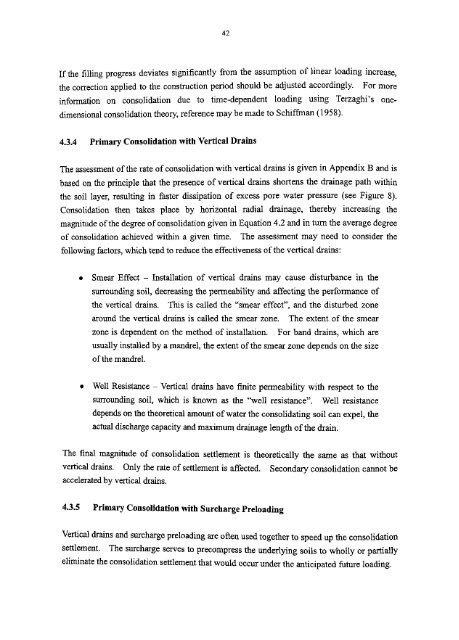PORT WORKS DESIGN MANUAL PART 3 Guide To - The University ...
PORT WORKS DESIGN MANUAL PART 3 Guide To - The University ...
PORT WORKS DESIGN MANUAL PART 3 Guide To - The University ...
Create successful ePaper yourself
Turn your PDF publications into a flip-book with our unique Google optimized e-Paper software.
42If the filling progress deviates significantly from the assumption of linear loading increase,the correction applied to the construction period should be adjusted accordingly. For moreinformation on consolidation due to time-dependent loading using Terzaghi's onedimensionalconsolidation theory, reference may be made to Schiffman (1958).4.3.4 Primary Consolidation with Vertical Drains<strong>The</strong> assessment of the rate of consolidation with vertical drains is given in Appendix B and isbased on the principle that the presence of vertical drains shortens the drainage path withinthe soil layer, resulting in faster dissipation of excess pore water pressure (see Figure 8).Consolidation then takes place by horizontal radial drainage, thereby increasing themagnitude of the degree of consolidation given in Equation 4.2 and in turn the average degreeof consolidation achieved within a given time. <strong>The</strong> assessment may need to consider thefollowing factors, which tend to reduce the effectiveness of the vertical drains:• Smear Effect - Installation of vertical drains may cause disturbance in thesurrounding soil, decreasing the permeability and affecting the performance ofthe vertical drains. This is called the "smear effect", and the disturbed zonearound the vertical drains is called the smear zone. <strong>The</strong> extent of the smearzone is dependent on the method of installation. For band drains, which areusually installed by a mandrel, the extent of the smear zone depends on the sizeof the mandrel.• Well Resistance - Vertical drains have finite permeability with respect to thesurrounding soil, which is known as the "well resistance". Well resistancedepends on the theoretical amount of water the consolidating soil can expel, theactual discharge capacity and maximum drainage length of the drain.<strong>The</strong> final magnitude of consolidation settlement is theoretically the same as that withoutvertical drains. Only the rate of settlement is affected. Secondary consolidation cannot beaccelerated by vertical drains.4.3.5 Primary Consolidation with Surcharge PreloadingVertical drains and surcharge preloading are often used together to speed up the consolidationsettlement. <strong>The</strong> surcharge serves to precompress the underlying soils to wholly or partiallyeliminate the consolidation settlement that would occur under the anticipated future loading.
















